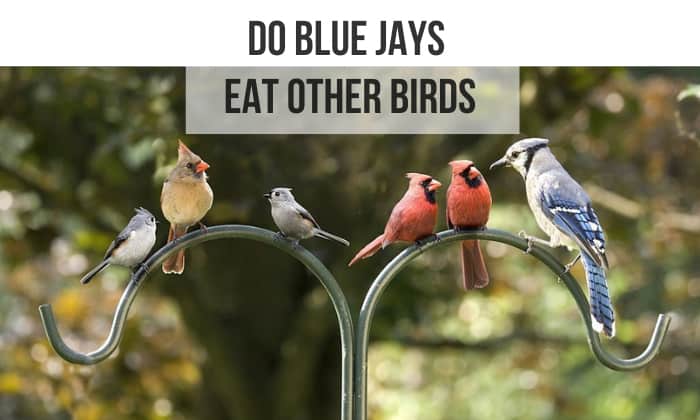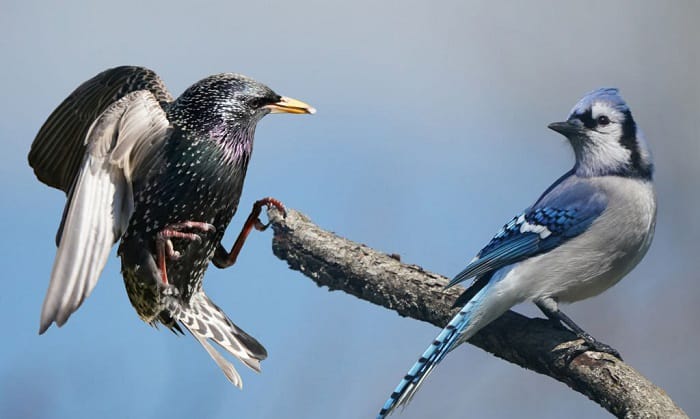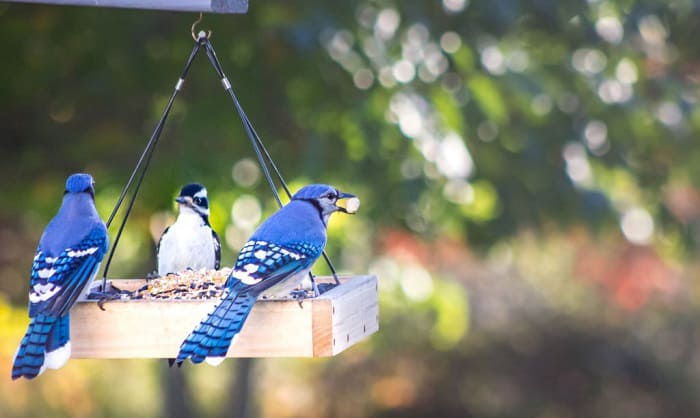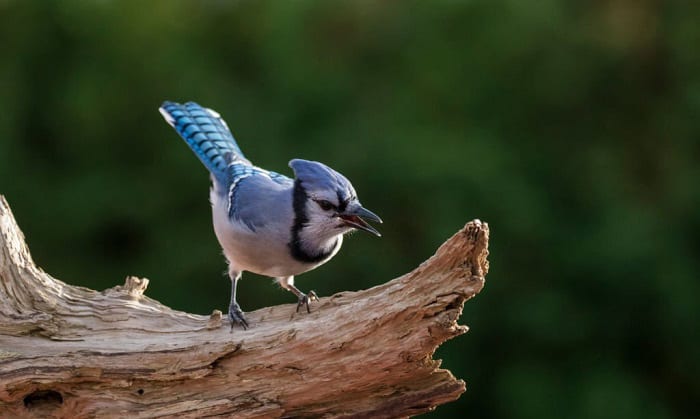Do blue jays eat other birds? Yes, but only on occasion. There are some cases where blue jays eat other birds eggs, fledglings, or small birds, but the chances of this happening are very slim. You’ll rarely see these songbirds feasting on other birds.
The common misconception of blue jays as active bird eaters is probably based on their aggressive and territorial behavior.
Let’s clear up this misunderstanding and learn more about blue jays’ characteristics, diet, and behavior. Read on.
Table of Contents
Do Blue Jays Eat Other Birds
The answer is both yes and no. There are studies where they found traces of eggs or birds in 1% of the total number of blue jays in the research. We can assume that the majority of the blue jay population doesn’t eat other birds, whether it is eggs or fledglings, in normal circumstances.
Blue Jay Food
The major component in a blue jay’s diet is vegetables, which take up 75% of their food intake throughout the year. This percentage can go higher when the cold months roll in. Some of their favorites are:
- Acorns
- Beechnuts
- Sunflower seeds
- Mixed grains
- Peanuts
- Small fruits
Blue jays have strong bills that can break open any hard-shelled nuts. They also eat meat in the form of young birds, pupas, insects, spiders, snails, and sometimes small rodents.
When Do Blue Jays Eat or Attack Other Birds?
Blue jays attack other birds and small animals for a reason. These birds are highly territorial and are always ready to get into a fight in the following situations:
- Defending their territories
- To get a bigger share of the food source
- When they feel unsafe
- During mating season
In some situations where a blue jay steals eggs or chicks from another bird’s nest could be due to the lack of food sources.
Are Blue Jays Aggressive Toward Humans?
The relationship between blue jays and humans is ambiguous since these birds avoid crossing paths with humans as much as possible. While you can tempt blue jays into dining on your backyard feeder, you can also get mobbed by them.
When a blue jay attacks humans, it is mostly because you are getting too close to their liking. It would be best to observe them from a distance, especially when you notice their crest raised higher than usual.
Can Blue Jays Attack Its Fellow?
Yes. Blue Jays are hostile birds when it’s breeding season, even to other blue jays. But this only happens when they are mating. On normal occasions, blue jay’s aggressive personality is projected exclusively onto other bird species and wildlife.
Blue Jay Characteristics
Blue jays have a large crest and a rounded tail. They measure between 25 to 30 centimeters, 34 to 43 centimeters in wingspan, and weigh 70 to 100 grams. Overall, they are larger than robins but smaller than crows.
These birds are known for their blue tail and wing, which makes them stand out from the green grass and brown leaves. The blue is noticeable on their head, changing to white and grey as it goes down their neck, chest, and stomach. Their legs, feet, bills, and lower throat are black. Blue jays shed their feathers in the late summer in the middle of June and September.
Blue Jay Behavior
Territorial and aggressive are two words you will often hear when describing blue jays’ behavior. They are notorious for forming a group and mobbing predators and intruders. You will often see them chase away other birds and monopolize bird feeders.
You can hear a blue jay from afar, thanks to their noisy jay! jay! calls. They can make a wide variety of noises and these carry for long distances. Blue jays can also make musical sounds and imitate hawk’s calls for deception and as a warning.
Blue jays are considered smart birds with human-like intelligence. They are skilled at mimicking sounds around them. Captive blue jays can use tools to get food into their cage. While other songbirds stay away from eating ants because of their awful taste, blue jays found a way to get rid of the bitterness by rubbing the ants on their feathers.
Facts About Blue Jays
- They often mimic the Red-shouldered Hawk’s call, either to trick other birds or let other blue jays know that there is a hawk nearby.
- You can tell the mood of a blue jay by looking at its crest. If it is raised, they are hostile. When lowered, they are at peace. It looks brushlike when they’re frightened.
- The brown pigment in their feathers is melanin.
- They can tell each other apart through the black bridle across their neck, nape, and face.
- Blue jay’s striking blue feathers appeared as it is because of the distortion of light. They are not blue!
- These blue birds sometimes rub ants under their feathers, an act called anting.
- Male and female blue jays have similar plumage.
- The blue jay is not an official avian of any state.
- Their migration pattern is unpredictable and strange.
Frequently Asked Questions
How do you keep blue jays from eating baby birds?
Sometimes, blue jays eat baby birds off the nest or steal them away. If you notice some blue jays hovering around the area where there’s a nest of baby birds, there are some things you can do to prevent blue jays from preying on the vulnerable fledglings.
Provide a secure nesting box with entry holes small enough for other birds to enter while deterring blue jays and other predators.
What birds bully blue jays?
Despite their reputation as big bullies, blue jays have quite a list of birds that harass them. Both adults and younglings cower before these avian species:
- Hawk
- Owls
- Crows
- Grackles
- Northern Bobwhites
- Northern Mockingbirds
- Mourning Dove
- Red-headed Woodpeckers
- Red-bellied Woodpeckers
Do blue jays steal other birds’ nests?
Yes. Blue jays ransack other birds’ nests now and then. They do this to provide food for their mates who are sitting on the eggs, waiting for them to hatch.
Do blue jays kill other birds?
They can. Blue jays are, by nature, aggressive. When blue jays fight to protect their territories or hunt, they can end up beheading other birds.
But this hardly happens since blue jays are not murderous species and only behave viciously when their food or territory is at stake.
Do blue jays eat hummingbirds?
Yes. Blue jays are known as one of the hummingbirds’ avian predators alongside the hawk and crow. They feed on hummingbird eggs and fledglings.
Conclusion
The answer to the question “Do blue jays eat other birds?” is yes! But they don’t do it regularly, only when the opportunity presents itself. Learning and understanding blue jays’ behavior and diet can help birders and homeowners protect any birds’ nests in their backyard. In addition, you can also safeguard yourself from mobbing blue jays.
Do you have some interesting blue jay information you want to share? Have you experienced being attasteal other birds’ nestscked by them or witnessed these blue birds looting a nest? Share your encounters with us in the comments below!

George and I became friends after a birdwatching trip with our new group. And we have been enjoying every adventure together. When he told me the idea of establishing a site that shares our experiences and fun, I immediately agreed. After trials and errors, here we have Thayerbirding.


















